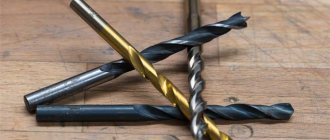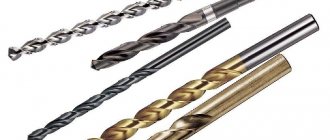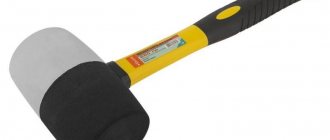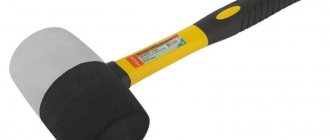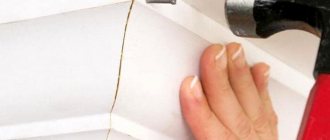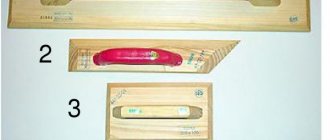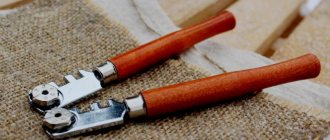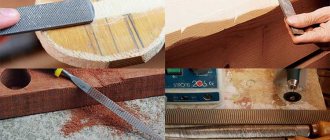For straight and curved cuts, a tool is used that, according to its operating principle, is similar to an ordinary saw, this is a jigsaw.
Depending on the installed blade, it can cope not only with wood, but also with other materials of varying strength, such as plastic and metal, plasterboard and ceramics.
A jigsaw is also used to make mortise cuts and even cut shaped holes on planes.
Purpose of the jigsaw
Unlike conventional saws intended for rough straight cuts, jigsaws are used to perform figured cutting.
Almost any intricately shaped cutout can be done with this structurally simple tool.
The special shape of the frame, similar to a bow saw, allows you to make precise longitudinal cuts from the end of the workpiece, deeply deepening the blade into the material.
A jigsaw is also convenient for making straight cuts with high precision.
A jigsaw is primarily used to make curved cuts in sheets of plywood, chipboard, fiberboard and similar materials.
This tool is suitable for shaping miniature workpieces, and due to the possibility of a curved path of the blade through the material, it is convenient for them to round corners on the workpiece.
Interesting decorative items for furniture, home, and even clothing can also be made using a jigsaw.
Carving with this tool has already gained popularity among DIY enthusiasts.
Moreover, artistic cutting of plywood products is a task that almost every person can handle.
Handling[edit]
Control is a problem with jigsaws; the blades are small and weak, the lower end completely lacking support. Good cutting control requires blade rollers to keep the blade level over the sole. In addition, thick plate saws are somewhat better than pressed steel for controlling the cutting line. To guide the jigsaw during a curved cut, it must be guided (rotated) and not forced to move sideways. Using sharp blades is also important to achieve a quality cut.
Device and characteristics
It should be noted initially that the tool is divided into two large classes: manual and electric jigsaws.
The former are more suitable for fine and precise work with small elements, while the latter are in most cases used where it is necessary to quickly make a shaped hole or make a straight cut.
The design of a manual jigsaw is extremely simple; it consists of the following elements:
• Small arched metal frame.
It is mainly made in the shape of the letter “P” or “C” from steel.
Its main feature is the large gap between the upper part and the stretched fabric.
This allows the frame not to rest against the edges of the workpiece, but to go around them.
If it is necessary to make a cut along a line that should not extend beyond the workpiece, then a hole is drilled in it.
The canvas is then removed from the frame, passed through this hole, and reattached to the frame.
• Blade – the working, sawing part of the tool with small teeth.
It is stretched between the ends of the frame (fixed with its fastenings).
It has one big drawback - low mechanical strength, which, coupled with the small size of the frame, makes sawing at a great distance from the edges of the part impossible.
The canvas itself often simply bursts and breaks off.
• Handle – an element that is installed on one side of the frame and is designed for convenient holding of the tool with one hand.
Made from wood, metal or plastic.
A standard electric jigsaw consists of:
- Housings with a comfortable handle and a start button, in which all electrical elements are hidden.
- Electric motor with gearbox.
- Stock.
- Files.
- Guide support plane fixed in the lower part of the body.
- Various optional additions for ease of operation: backlight, pendulum switch, additional guide mechanism, laser pointer, etc.
The operating principle of an electric jigsaw is the reciprocating movements of the saw at high speed.
It is fixed in a rod, which moves due to the transfer of energy from the engine through a gearbox.
Sawing occurs perpendicular to the surface being processed.
Dimensions and weight
The most common hand jigsaws weigh 285 g with a blade length of 130 mm and a sawing depth of up to 300 mm.
But there is a tool with the following parameters:
- Weight: 120 – 450 g;
- Sawing depth: 100 – 400 mm;
- Blade length: 22 – 300 mm.
Parameters of typical electric jigsaws:
- Weight: 2 – 5 kg;
- Length: 180 – 300 mm;
- Width: 60 – 120 mm;
- Height: 180 – 400 mm;
- Saw blade length: 40 – 250 mm.
What rules will protect against injury?
The mechanism seems harmless and simple only at first glance.
When performing any work, you must follow basic safety rules to avoid injury. There is work to be done
Safety rules when working with a jigsaw
with a sharp, metal part that hurts painfully, and on occasion will reach the bone. Before work, you need to inspect the jigsaw, check that the handle is firmly and firmly secured. If the fastening is broken during creative actions, the handle will fall off, but the hand will continue to move until it comes into contact with the metal pin. Which won't bring anything good.
A workbench or metalworking table must also be equipped with all special devices for safe work. Sometimes even a fall from a simple, unstable chair can cause injury and bone fractures.
The master always tries to take a closer look at his creation. This should not be done during work processes. If you lower your head too low, shavings will get into your eyes.
When a person gets used to a jigsaw and overcomes all the difficult moments, working with it becomes a real passion, and crafts become a source of pride. But a hobby can be combined with a source of income. Manual labor has always been valued much more than mechanical stamping.
- Related Posts
- Which electric jigsaw is better to choose - 2021 rating
- Rating of manual riveters
- How to choose a spray gun
« Previous entry
Types of jigsaws
The tool is divided into several classes, depending on various parameters.
By type of drive:
Manual
The work is performed through the translational movements of the tool held with one hand.
Structurally, this is the simplest option.
Mechanical
It is used primarily in the woodworking industry to perform figured cuts on long products.
It is a kind of machine.
It consists of a frame, a saw, its drive and tension device, guide shafts, and rotary devices.
It can have movable and fixed positioning of the saw.
In the first case, the workpiece is fixed on the bed table.
Electric
Can be domestic or professional.
In the first case, the tool has low power and is able to cope with metal up to 4 mm wide and wood up to 50 mm wide.
The power of professional jigsaws starts from 580 W and is used when working with metal up to 10 mm thick and wood up to 130 mm thick.
A jigsaw, in turn, can be:
• Network – works from a household network.
• Rechargeable – runs on a removable battery.
By size and general design:
• Stationary - performed in the form of fixed dimensional machines.
• Manual – when working, they are held in the hand.
• Tabletop - made in the form of small machines that are installed on a flat surface, or attached with a clamp (like a clamp) to its edge.
Structurally, they represent a table with a canvas holder fixed above it.
During operation, the workpiece moves relative to the saw blade.
A special feature of the tool is the ability to select the cutting angle in any plane.
If necessary, the blade can be rotated perpendicular to the vertical, and the vertical jigsaw is transformed into a horizontal one.
Depending on the working part, jigsaws are divided into:
• Tool with blade – classic option.
The file is either tensioned in the frame or fastened with one side into a clamp (on electric versions).
• Band saws - the saw blade is made in the form of a flexible closed ring - a tape.
Once installed on the tool, it moves in a circle along special rollers, one or more of which perform tension.
As a rule, band jigsaws are made in the form of stationary machines.
Working with different materials
Jigsaws can be classified depending on what material the blade is designed to work with, as well as what work it is intended for:
• On wood. Available for quick, clean or shaped cuts.
• For metal.
• For polymer materials.
• For specific tasks.
As an example, we can cite options for glass and ceramics, where the working part of the blade is not teeth, but a coating of diamond chips or tungsten carbide.
• Versatile.
Suitable for working with most materials, such as wood, metal or plastic, but has low cut quality.
Among other things, there are so-called jewelry jigsaws, which are classified as hand tools.
They are small in size, have a shallow cutting depth and have adjustable blade spacing.
For accurate work with miniature parts, strings are used instead of classic saw blades.
A transformer jigsaw is a subtype of the electric version of this tool.
Its difference from a classic power tool is that the front part, in which all the working elements are located, including the motor, gearbox, blade and sole, can be set at different angles to the handle in one movement.
Thus, the jigsaw can easily be transformed into a small reciprocating saw.
Another subtype of power tool is a mushroom jigsaw.
This tool has a special body shape, the top of which is grabbed by hand.
A slider is used as a switch.
Convenient because it allows you to work in limited space.
They are comfortable cutting the workpiece from any side, and even from below.
Jigsaws are used so often that if this tool is not available, a special attachment for a drill or screwdriver can be used.
This option is a housing, inside of which there is a mechanism that converts the rotational movement of the drill into the translational movement of the blade.
A laser jigsaw is a jigsaw with a laser pointer that allows you to produce an accurate and even saw on the material being processed.
Selection of canvas
The versatility of such a working tool as a jigsaw is primarily due to the ability to replace the blade. By replacing only one element of the tool, you can get a design designed to process a completely different material. There are several main directions in which such fabrics are produced:
- for metal;
- for wood
- mixed type.
Typically, for metal processing, blades with a large number of teeth per unit length are used (the so-called TPI index - teeth per inch). Mixed teeth have a rather complex shape.
There are other features of the teeth in the blade. Ground and set teeth are designed for high cutting speeds and large vibrations, and to ensure a smooth cut, non-set teeth are used. At the same time, the lack of wiring reduces the processing speed. Wavy milled teeth are used only in cases where the cutting requirements are not strict.
The canvases differ in the method of fastening: T-shaped and U-shaped.
They also have special colored markers on the shank:
- white – processing of wood and metal surfaces;
- gray - jigsaw for wood (exclusively);
- red - plastic;
- blue - only for metal surfaces;
- black - special for different materials.
The marking also indicates the length of the blade:
- 1 - up to 75 mm;
- 2 - up to 90 mm;
- 3 - up to 150 mm;
- 7 - 150 mm and above.
The size of the teeth is indicated by the letters ABCD - from largest to smallest.
Other markings:
- F - for bimetallic sheet;
- O - for cutting curved lines;
- R - reverse tooth (requires securing the part);
- P - thicker blade, which allows better cutting at an angle;
- X - universal blade;
- HM - reinforced steel.
Markings may differ from one manufacturer to another, but the characteristics indicated are usually the same as those indicated above.
Thus, you can choose the right blade or blades for the job based on the markings alone, and if you have a unit of sufficient power, you can process any surface.
